Researchers at the University of Washington have examined a deep-learning approach to understanding how small changes to initial conditions impact weather forecasts.
Deep learning in weather forecasts
The resulting paper, named Predictability Limit of the 2021 Pacific Northwest Heatwave From Deep-Learning Sensitivity Analysis, was published in Volume 51, Issue 19 of Geophysical Research Letters. It was written by P Trent Vonich, a PhD student at the University of Washington, and Gregory J Hakim, a professor of atmospheric and climate science at the University of Washington.
In their study, Vonich and Hakim leveraged recent advances in machine learning (ML) to find optimal initial conditions using the backpropagation method within deep-learning frameworks. This approach iteratively searches for initial conditions that produce the best forecasts. The researchers applied this method to GraphCast forecasts of the June 2021 Pacific Northwest extreme heatwave. They found that small changes to the initial conditions yield nearly perfect 10-day weather forecasts of the heat wave in the GraphCast and Pangu-Weather models. According to the team, this research suggests that a significant increase in forecast skill may be possible from existing observations through better estimates of initial conditions.
Near-perfect 10-day weather forecasts
In the paper’s abstract, Vonich and Hakim state, “The traditional method for estimating weather forecast sensitivity to initial conditions uses adjoint models, which are limited to short lead times due to linearization around a control forecast. The advent of deep-learning frameworks enables a new approach using backpropagation and gradient descent to iteratively optimize initial conditions, minimizing forecast errors. We apply this approach to the June 2021 Pacific Northwest heatwave using the GraphCast model, yielding over 90% reduction in 10-day forecast errors over the Pacific Northwest. Similar improvements are found for Pangu-Weather model forecasts initialized with the GraphCast-derived optimal, suggesting that model error is an unimportant part of the perturbations. Eliminating small scales from the perturbations also yields similar forecast improvements. Extending the length of the optimization window, we find forecast improvement to about 23 days, suggesting atmospheric predictability at the upper end of recent estimates.”
In related news, in a study published in the Bulletin of the American Meteorological Society, a team of University of Washington scientists has filled longstanding gaps in the process of sublimation – the process by which snow transforms directly from a solid (snow) to a gas (water vapor). Click here to read the full story.



